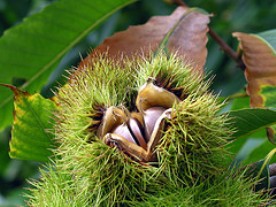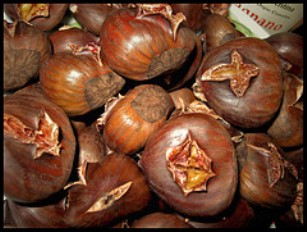These shiny brown nuts that were immortalized in the famous Christmas song are now ripe and ready for cooking, open fire or not.
But after the arboreal annihilation caused by blight to the great American Chestnut tree we now have to import over $20 million worth of chestnuts each season. In the early twentieth century over three billion of these once ubiquitous trees perished, the lumber of which was used from rail road ties to telegraph poles. But all is not lost; The American Chestnut Foundation is breeding trees with the ability to survive blight so pretty soon we will be harvesting many more home grown chestnuts.
Ancient writings from China, Asia Minor and the Mediterranean region all mention chestnuts and they have been cultivated in France since 11th C. Chestnuts were a staple food of the poor before the introduction of the potato. Your European rural family cook would spend up to 3 hours a night cursedly peeling these little nuts for the next day’s dinner. When the Pilgrims arrived in the early 1600's the American Indians taught them how to grind chestnuts into flour. While over in Corsica they were also drying and milling them as the original ingredient for polenta or pulenda as they call it. The Corsicans also have a strange tradition of serving twenty-two dishes comprising of chestnuts as a wedding feast.

High in carbohydrates and low in fat and calories, the chestnut is the only nut to contain significant amounts of vitamin C. Residing in a hard, shiny brown shell the kernels inside are soft and floury. Some say they are similar in flavor and texture to a potato, only sweeter. Roasting them brings out their rich earthy nuttiness. Unfortunately they are highly perishable and must be kept refrigerated.

Savory or sweet there’s a chestnut dish for everyone. Whether roasting, boiling or steaming it’s essential to cut an X on the flat side (or pierce with a fork) before cooking, to prevent any messy explosions in your kitchen. Chestnuts needn’t be confined to roasting or for stuffing a festive bird. Liquidized with differing amounts of chicken stock will produce an unusual soup, sauce or puree. Or how about a chestnut ravioli? The Japanese like to pair their chestnuts with rice while Gordon Ramsay cooks a lavish chocolate and chestnut torte served with chestnut cream.
Chestnut flour imparts its rich sweet flavor to cake recipes, an unusual pizza maybe or bread that keeps for up to two weeks.

While the majority of chestnuts hold several small kernels, a marron chestnut contains one giant nut. And these are what the French use to make the caviar of confections known as Marron Glaces. They are poached in a vanilla sugar syrup for 48 hours and then glazed which gives them their unique delicate, sweet/salty fudgyness. But at $4 or $5 a piece it may well pay to have a go at making your own.
Photos courtesy of Javadoug, Foodtrail, Northern Star, Roboppy - flickr